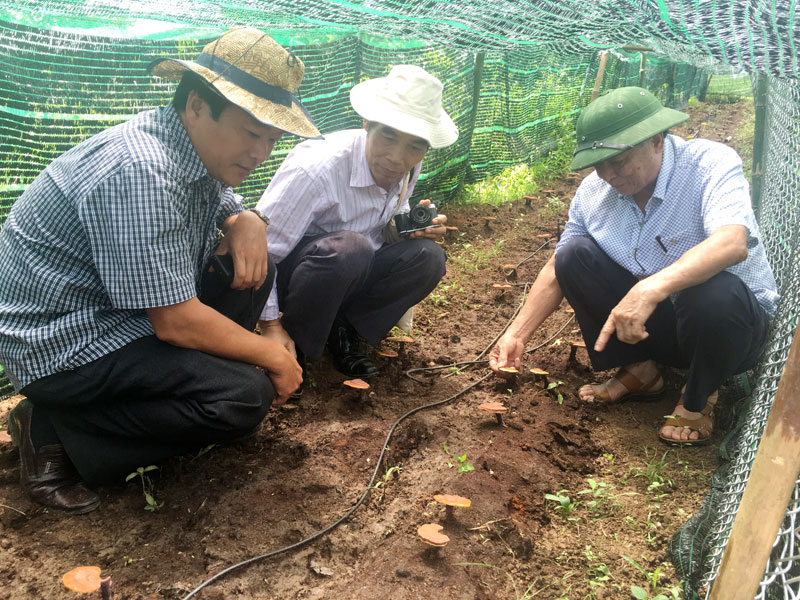
(HBO) – Lingzhi mushroom, a valuable medicinal herb, has been grown in some farms in Hoa Binh province, including the centre for scientific and technological application under the provincial Department of Science and Technology, and farms in Mong Hoa commune (Ky Son district) and Dong Tam commune (Lac Thuy district). Recently, Linh Dung organic farm in Dong Ngoai village, Vinh Tien commune (Kim Boi district) also cultivated the medicinal fungus on a trial basis. The farm has just harvested the first batch of lingzhi mushroom.

Photo: Linh Dung farm owner in
his red lingzhi garden which is ready for harvest
The owner of Linh Dung farm, PhD Nguyen Hong Yen, wants to popularise his
lingzhi mushroom which is cultivated using organic method. In fact, the
mushroom can only survive in natural and non-chemical environment. Any chemical
intervention from the grower can kill the plant.
Yen
said that there are six kinds of lingzhi mushrooms and the identification is
made based on their colour. He selected red lingzhi to plant on a trial basis
under the technical transfer of Nguyen Tien Ky from the institute of science
and technology research, training and counseling under the Vietnam Union of
Science and Technology Associations.
In
preparation for the garden, the grower had to prepare materials a couple of
months earlier (mostly in the outset of the year), dig ditches and raise beds
for the mushroom. Soil in the beds must be replaced by "lim” sawdust purchased
from wood logging businesses. The end of April was the most ideal time for spreading
substrate on the sawdust. After that, the substrate will be covered with
another layer of sawdust.
Notably, for successful testing plantation, the owner had to mix sawdust with lime
to prevent fungal infections before planting the mushroom. The mixture was made
from 20-30 kilogrammes of lime per one ton of sawdust. In an area of
300 square metresfor mushroom plantation, he used four tonnes of sawdust.
The technique is not that hard to follow, Yen affirmed, adding that it requires
suitable humidity for the mushroom to develop well, which should be maintained
at 80-90 percent in the air and around 60-70 percent inside the substrate. It
is also essential to use lime (calcium hydroxide) to treat sawdust in order to prevent
diseases for the mushroom.
With 1,000 mushroom kits supplied by the institute of
science and technology research, training and counseling, the Linh Dung Farm
had its first harvests at the end of June or 60 days after cultivating. After
the mushrooms were dried under sunlight for several days using quite
complicated methods, they were packed or steeped in wine. Yen said he has harvested
about
10 kgof dried lingzhi from the first crop, which fetched about 1.7 million VND per
kg. Yen has invested over 30 million VND to buy the 1,000 mushroom kits, so he
believed he would recover the investment on the second crop which will be ready
for harvest in a month. The mushroom can be harvested 4-5 times a year for a
period of at least 4-5 years.
Tests by the
Instituteof
Medicinal Materials in
HCM
Cityshowed lingzhi grown in the farm was free of harmful residues and bacteria.
The farm owner is brimming with hope, and plans to purchase
2,000 more lingzhi growing kits to expand production. At present, the farm does
not have enough mushrooms to sell.
Since the beginning of this year, under the direction of the Department of Agriculture and Environment, the Sub-Department of Agricultural, Forestry, and Fishery Product Quality Management has strengthened the integration of the professional activities to promote and guide the organizations and individuals in the production and trading of agricultural, forestry, and fishery products to comply with the legal regulations regarding the use of chemicals, pesticides and veterinary medicines in crop cultivation, livestock farming and aquaculture. They also provide guidance to processing and manufacturing establishments on keeping the records to trace the product origins and using food additives from the approved list according to the regulations.
Hoa Binh province saw a significant rise in state budget revenue in the first two months of 2025, heard a meeting chaired by Vice Chairman of the provincial People’s Committee Quach Tat Liem.
Ha Thi Ha Chi, a 26-year-old graduate in law, has taken an unconventional path by returning to her hometown in Mai Chau district to establish the Tong Dau Cooperative, creating stable jobs for local women and bringing Thai ethnic brocade weaving to the global market.
As the Lunar New Year 2025 approached, pork prices surged, creating a profitable season for farmers in Tan Vinh commune, Luong Son district. Taking advantage of the rising demand, Can Minh Son, a farmer from Coi hamlet, sold over 30 pigs at 69,000 VND/kg, each weighing more than 100 kg. After deducting expenses, his family earned a profit of over 50 million VND.
alternate member of the Central Party Committee, Secretary of the Hoa Binh provincial Party Committee Nguyen Phi Long on March 5 had a working session with Yan Jiehe, Founder and Chairman of the China Pacific Construction Group, one of China's largest private corporations in the field of transport infrastructure. Deputy Secretary of the provincial Party Committee, Chairman of the provincial People's Committee Bui Duc Hinh and leaders of provincial departments and sectors also attended the working session.
The electronic printed circuit board (PCB) manufacturing and processing plant of Japan’s Meiko Group, located at Da River Left Bank Industrial Park in Hoa Binh city with a total investment of over 200 million USD, is expected to create thousands of jobs and make a significant contribution to the local budget.



